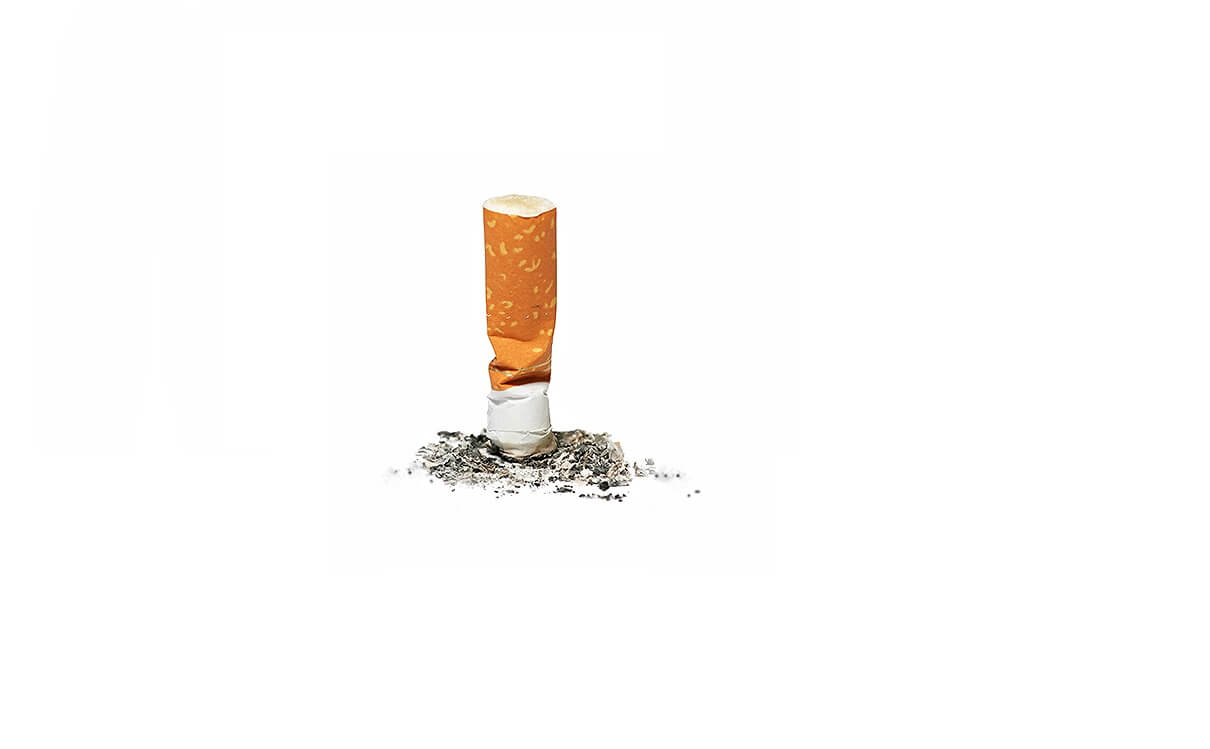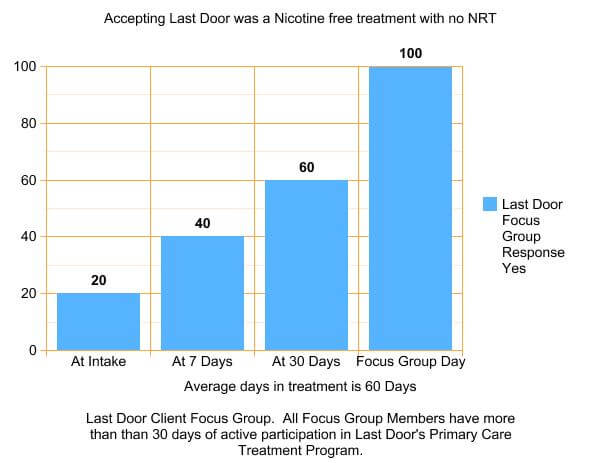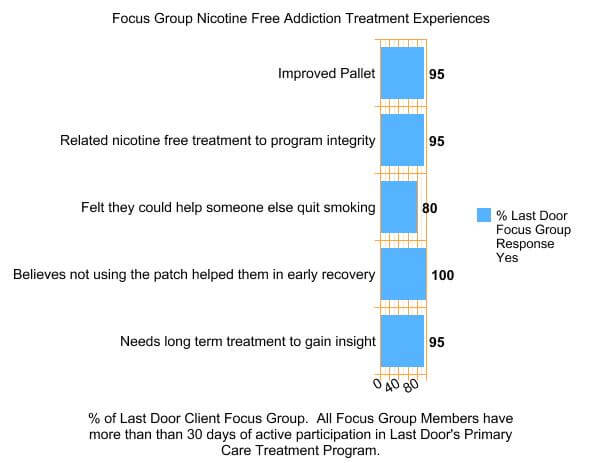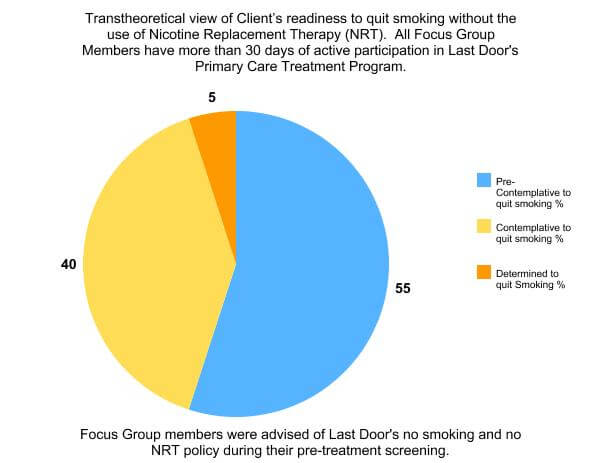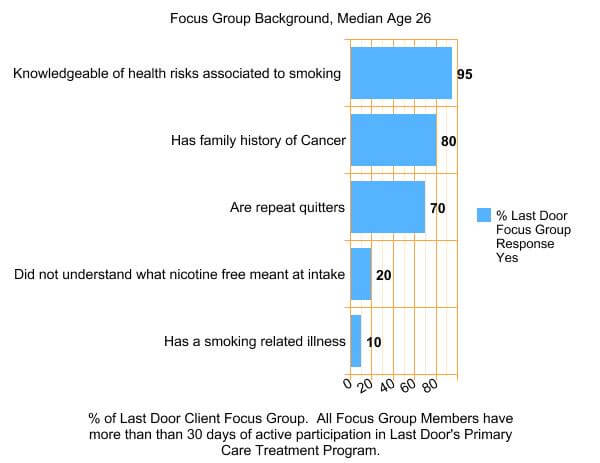Evidence indicates people who quite smoking while in treatment, have better results at recovery. Get your health back, all of it.
Nicotine Addiction Treatment
Last Door Smoking Cessation Program
Last Door has been nicotine free since 1997 and is a pioneer in the smoking cessation movement. At Last Door nicotine abstinence goes beyond not smoking on the property – residents and staff stop smoking entirely. Last Door’s nicotine addiction treatment program has helped thousands of people quit smoking. Most clients come to Last Door addicted to nicotine, below you will see research on the benefits of have a smoke free treatment centre. It is possible, please entering addiction treatment can quit smoking, it is easier than you think. Peer support is key to helping residents get through the nicotine withdrawal in the first few days of treatment.
Nicotine Addiction Treatment Admissions
Call our intake line to start the telephone screening process, our consultation services will help determine treatment readiness and suitability.
Click here for information pertaining to admissions.
What causes nicotine addiction?
Nicotine is an addictive drug. It causes changes in the brain that make people want to use it more and more. In addition, addictive drugs cause unpleasant withdrawal symptoms. The good feelings that result when an addictive drug is present — and the bad feelings when it’s absent.
- Cigarettes and other forms of tobacco are addicting.
- Nicotine is the drug that causes addiction.
- Pharmacologic and behavioural characteristics that determine tobacco addiction are similar to those that determine addiction to drugs such as heroin and cocaine.
Last Door Clients Experiences with Nicotine Addiction Treatment
Client Experiences
“It wasn’t until 60 days that I realized no smoking was a good idea”
“I had a desire to quit but couldn’t on my own”…. 20-year smoker
“I promised my deceased family I would quit everything nicotine included.”
“Mentally made me feel how addicted I was”
“Alternative health choices were made available immediately”
“I always smoked while I was on the patch”
Methods Last Door uses to help you stop smoking
- Organizational buy-in included smoking cessation by the entire staff team to support the client who initiated abstinence.
- Staggered intakes permitted incoming clients to join a culture of abstinence and feel supported
- No bargaining with the non-smoking norm. Parents, friends, visitors all are required to support the culture while alumnus share their experience with current clients. Counselling and support are provided to all clients and include elements of CBT and behaviour modification
- Psycho-educational & Process Groups are used to educate and support new clients and enforce the cultural norms for the entire community.
- Recreational and Traditional Supports are incorporate – clients participate in Yoga, Acupuncture, Exercise, Lifestyle and Health groups.
- Chewing bubble gum rather than nicotine gum and using patches serve as an alternative based on research and practice.
Opportunities clients experience in a nicotine environment
- Social Bonding
- Leading Edge Thinking
- Reduction of Chronic illnesses
- Reduce Maintenance Costs
- Reduce theft and petty crime
- Reduce relapse rates for other drugs
What else does nicotine do to the body?
When a person smokes a cigarette, the body responds immediately to the chemical nicotine in the smoke. Nicotine causes a short-term increase in blood pressure, heart rate and the flow of blood from the heart. It also causes the arteries to narrow. The smoke includes carbon monoxide, which reduces the amount of oxygen the blood can carry. This, combined with the nicotine effects, creates an imbalance between the demand for oxygen by the cells and the amount of oxygen the blood can supply.
How does nicotine in cigarettes increase the risk of heart attack?
Cigarette smoking may increase the risk of developing hardening of the arteries and heart attacks in several ways. First, carbon monoxide may damage the inner walls of the arteries, encouraging fatty buildups in them. Over time, this causes the vessels to narrow and harden. Nicotine may also contribute to this process. Smoking also causes several changes in the blood that make clots — and heart attack — more likely.
What are the symptoms of nicotine withdrawal?
- irritability
- impatience
- hostility
- anxiety
- depressed mood
- difficulty concentrating
- restlessness
- decreased heart rate
- increased appetite or weight gain
How long does nicotine stay in the body?
From 85–90 percent of nicotine in the blood is metabolized by the liver and excreted from the kidney rapidly. The estimated half-life for nicotine in the blood is two hours. However, smoking represents a multiple dosing situation with considerable accumulation during smoking. Therefore, it can be expected that blood nicotine would persist at significant levels for six to eight hours after smoking stopped.
Nicotine Free Smoking Cessation supports recovery from other addictions Last Door has well over a decade of success in Smoking Cessation in long term residential Alcohol and Drug treatment. Last Door delivers treatment for Substance abusers who, as a population are more likely to smoke cigarettes. Research on the availability of smoking cessation services in addiction treatment is limited to a small number of studies. Data collected in the 1990s in Minnesota revealed that very few treatment organizations assessed clients for their tobacco use or offered smoking cessation services. Many recovering people die from smoking-related diseases.
Recovering substance users are interested in smoking cessation and are able to stop smoking. Last Door Recovery Society has been providing quality addiction treatment services for individuals and families for 28 years and smoking cessation for 14 years. The society is respected and well known in the treatment field and received the Award of Excellence in Addictions by the Association of Substance Abuse Programs of BC in 2005.
Last Door addiction treatment program offer a continuum of care that includes group and one to one counselling, peer support, balanced diet and nutrition, recreation, positive socialization, family counselling, holistic therapies like acupuncture, naturopathic therapies and yoga and a solid continuing care program. A key facet of the Last Door experience is immersion in a culture of recovery. Participants are able to become part of a dynamic and healthy community that facilitates and enhances positive change and provides support beyond the treatment experience. This prepares them with all the resources they need for when clients return to their home communities.
What does the Science say about Nicotine Replacement Therapy
- Nicotine Abstinence Improves Addiction Treatment Recovery Rates (Proshaska 2010)
- In hospital patients where NRT was given as regular daily patches plus and an inhalator to be used as needed, did not add to the smoking cessation rate achieved at 1 year by regular advice and support (S Hand et al Thorax International 2002)
- Nicotine Abstinence Improves Addiction Treatment Recovery Rates (McDonald, Roberts & Descheemaeker 2000)
- How effective is the patch in comparison to other methods of smoking cessation? In a large scale review of 3,000 interventions, simple advice from a physician raised long term quit-rates from 7.9% to 10.2%. (If this is the basis for comparison, then perhaps it is assumed people quit on their own at a rate of 7.9%.) The authors cite “a recent study found a 24 week abstinence rate of 11.0% with a nicotine patch, compared with a rate of 4.2% with a placebo patch.” S Hand et al Thorax International 2002

